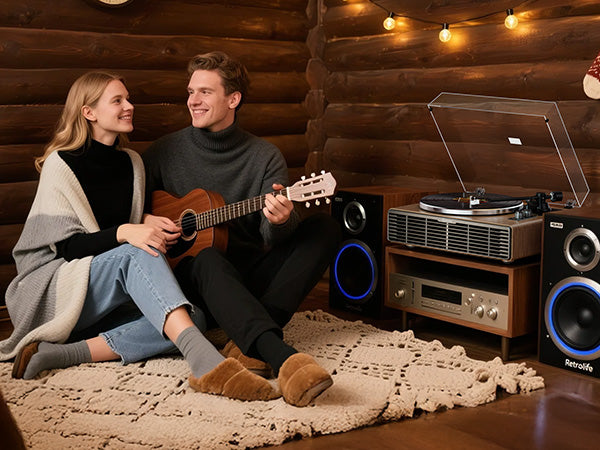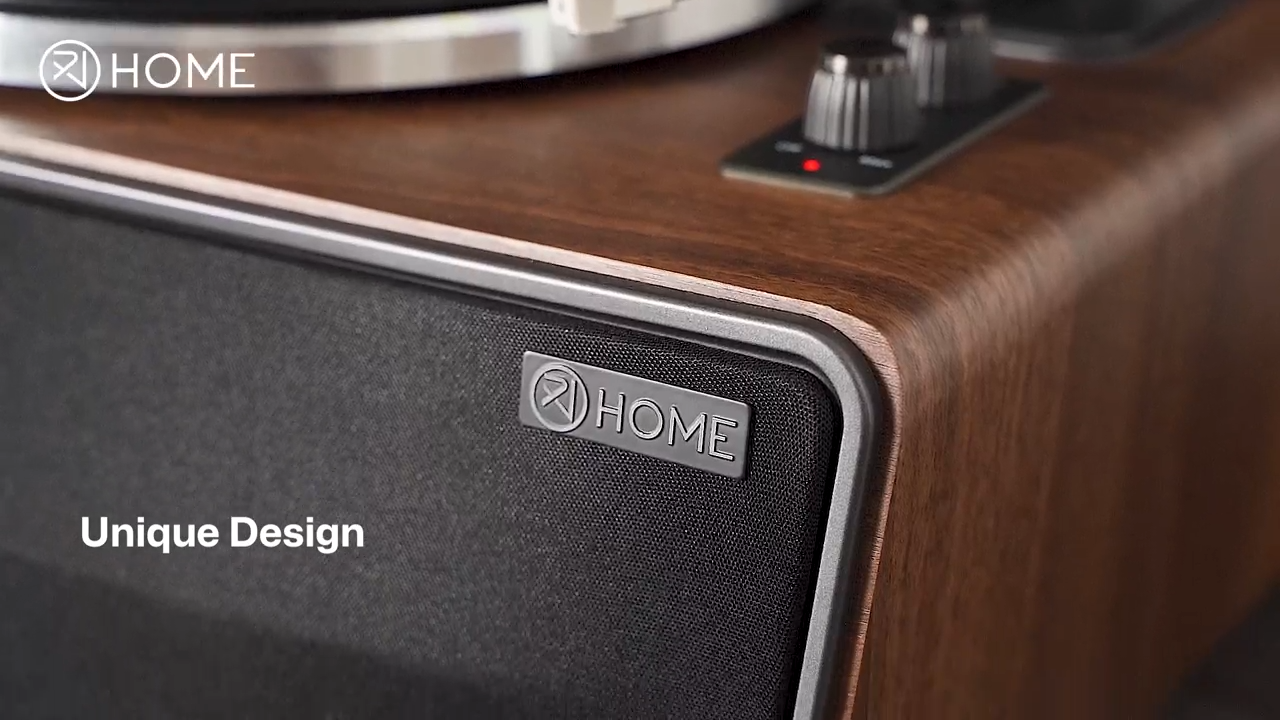The resurgence of vinyl records has brought with it a renewed appreciation for the unique listening experience this analog format offers.1 At the heart of any vinyl setup lies the crucial role of the speakers, which serve as the final link in the audio chain, translating the delicate vibrations etched on the vinyl into the sounds that fill the listening space.2 Assembling a vinyl listening system provides enthusiasts with a wide array of choices, allowing for a personalized setup tailored to individual preferences and sonic goals.1 The enduring appeal of vinyl suggests that listeners are often seeking a more engaging and potentially higher-fidelity audio encounter, making the selection of appropriate speakers a critical element in achieving this desired outcome. Furthermore, the variety of components available underscores the importance of understanding the options to make informed decisions.
Decoding Speaker Types for Vinyl
When embarking on the journey of selecting speakers for a vinyl setup, one of the primary decisions involves choosing between active and passive speaker types. Each offers distinct advantages and disadvantages that cater to different needs and preferences.
Active (Powered) Speakers: Simplicity and Convenience
Active speakers, also known as powered speakers, are characterized by the inclusion of built-in amplifiers, and often preamplifiers, within the speaker enclosure itself.2 This integration offers a simplified setup, as it minimizes the number of separate components required to produce sound.2 For individuals with limited space or those who prefer a minimalist aesthetic, active speakers can be particularly appealing.6 Many active speakers also come equipped with integrated volume controls and multiple input options, enhancing their versatility.5 A significant benefit of active speakers is that their internal amplifiers are typically designed and optimized specifically for the speaker's drivers and enclosure, ensuring a harmonious and efficient system.6 This synergy can lead to excellent audio performance without the need for extensive technical knowledge in matching separate components.
However, the integrated nature of active speakers can also present certain drawbacks. They tend to be bulkier than passive speakers due to the inclusion of internal electronics.2 Additionally, the ability to upgrade individual components, such as the amplifier, is limited, as they are built into the speaker.8 While active speakers offer a convenient all-in-one solution, some vinyl enthusiasts and audiophiles prefer the flexibility of separate components to fine-tune their sound quality and customize their systems to a greater extent.2 The ease of use associated with active speakers makes them an attractive option for those new to vinyl or who prioritize simplicity in their setup.
Passive Speakers: Flexibility and Customization
In contrast to active speakers, passive speakers do not include built-in amplifiers and necessitate the use of an external amplifier to provide power.2 This separation of components provides greater flexibility in mixing and matching speakers and amplifiers according to individual preferences and sonic goals.2 The ability to select high-quality separate components often allows for the potential to achieve a higher level of sound quality tailored to specific listening tastes.6 Furthermore, passive systems offer the advantage of independent upgrades, allowing users to replace speakers or amplifiers as their needs or budget evolve.6 For many, passive speakers represent a more traditional "hi-fi" approach to audio reproduction.7 Without the integrated amplifier, passive speakers can often be lighter than their active counterparts.2
The primary disadvantage of passive speakers lies in the increased complexity of the setup. They require more components, including a separate amplifier, and involve more intricate wiring.2 Additionally, using passive speakers necessitates careful matching of the amplifier and speakers, particularly in terms of impedance and power handling, to ensure optimal performance and avoid potential damage.3 Ultimately, passive speakers are dependent on external amplification to function.2 This type of setup appeals to users who are deeply invested in audio quality and enjoy the hands-on process of building and refining their sound system.
Understanding the Need for a Preamp
Regardless of whether one chooses active or passive speakers, a crucial element in a vinyl setup is the preamplifier, often referred to as a preamp. The signal produced by a turntable's cartridge is at a very low level, known as phono level, which is insufficient to drive speakers directly.2 The preamp serves the essential role of boosting this weak phono signal to a stronger line level, which is the standard operating level for most audio equipment.2 Furthermore, the preamp applies the RIAA equalization curve, a standardized equalization process used during vinyl record mastering and playback to ensure accurate tonal balance.20
Preamplification can be integrated into various components of a vinyl system. Some turntables come equipped with a built-in preamp, offering added convenience.2 Many integrated amplifiers, commonly used with passive speakers, also include a phono stage, which is a dedicated preamp circuit for turntables.5 In the realm of active speakers, some models incorporate a built-in preamp, simplifying the connection process for turntables without their own preamp.2 For setups where the turntable, amplifier, or active speakers do not have a built-in preamp, a standalone external preamp can be added to the audio chain.2 When choosing speakers, it is essential to ascertain whether the turntable has a built-in preamp to ensure the correct amplification path is established.2 Understanding the role and availability of a preamp is a foundational aspect of setting up a vinyl system.
Key Considerations for Choosing the Right Speakers
Selecting the ideal speakers for a vinyl setup involves careful consideration of several key factors, each contributing to the overall listening experience.
Sound Signature: Tailoring to Your Sonic Preferences
The sound signature of a speaker refers to its unique tonal characteristics, essentially how it colors the sound. Understanding these characteristics is crucial for aligning speaker choice with individual listening preferences. Generally, sound signatures can be categorized as warm, bright, or neutral.
Warm Sound Characteristics: Speakers with a warm sound signature tend to emphasize the bass and lower midrange frequencies.24 This often results in a sound described as "comfy," "musical," and "pleasant," with vocals and bass instruments sounding more prominent.28 Warm speakers can provide a richer, fuller sound, particularly beneficial for genres like blues, jazz, folk, and classic rock, where the richness of vocals and the depth of bass play a significant role.27
Bright Sound Characteristics: Bright speakers, on the other hand, emphasize the higher treble frequencies.24 This can lead to a sound that is perceived as "airy," "detailed," and "crisp," making high-frequency elements like cymbals and acoustic guitar strings stand out more.27 While some listeners appreciate the enhanced clarity and detail, an overly bright sound can sometimes be fatiguing or even harsh, especially during extended listening sessions.26 Bright sound signatures can be well-suited for classical, jazz, or acoustic music where clarity and a sense of space are often desired.27
Neutral Sound Characteristics: A neutral sound signature aims to reproduce audio as faithfully as possible, without adding any significant emphasis to any particular frequency range.24 The goal is to present the music exactly as it was recorded, without any coloration.26 Neutral speakers are often preferred for studio monitoring and by audiophiles who prioritize accuracy and transparency in their listening experience.26
Identifying the ideal listening profile involves considering personal preferences for different sonic characteristics.27 Music genre preference can be a strong indicator, as different sound signatures tend to complement various music styles.27 Ultimately, listening to a variety of speakers is the most effective way to discern personal preference and find the sound signature that resonates most with individual tastes.13
The Listening Space: Room Size and Acoustics
The characteristics of the listening environment, particularly the room size and its acoustic properties, play a significant role in how speakers will sound.
Impact of Room Dimensions on Sound: Larger rooms provide more space for sound waves to develop and can typically accommodate more powerful speakers.37 However, larger spaces can also be prone to echoes and reverberation due to the increased distances sound waves travel before reflecting off surfaces.38 In contrast, smaller rooms may be better suited for more compact bookshelf speakers.6 These smaller spaces can sometimes suffer from bass buildup, where low frequencies are amplified due to reflections off walls, leading to a "boomy" or "boxy" sound.6 The shape of the room and the materials used in its construction also significantly influence how sound waves are reflected and absorbed, affecting the overall acoustics.38
Speaker Size and Power Considerations for Different Spaces: For larger listening rooms, floorstanding speakers or larger bookshelf speakers with higher power handling capabilities are often recommended to adequately fill the space with sound.33 Smaller rooms can be well-served by bookshelf speakers, which are more compact and can still deliver high-quality sound without overwhelming the space.6
A Brief Note on Room Treatments: While not always necessary, incorporating room treatments such as rugs, curtains, and acoustic panels can significantly improve the sound quality in a listening room.40 These treatments help to control unwanted sound reflections and reverberation, leading to a clearer and more focused audio experience.
Technical Compatibility: Impedance and Power Handling
For those opting for passive speakers, understanding the technical aspects of impedance and power handling is essential for ensuring compatibility with the amplifier and achieving optimal performance.
Understanding Speaker Impedance and Amplifier Matching (for Passive Speakers): Speaker impedance is a measure of the electrical resistance a speaker offers to the flow of current from an amplifier, measured in Ohms (Ω).3 Matching the speaker's impedance to the amplifier's recommended output impedance range is crucial for maximizing power efficiency and preventing damage to both components.3 Using speakers with an impedance lower than the amplifier's rating can cause the amplifier to overheat and potentially lead to distortion or failure.3 Conversely, a significant impedance mismatch can result in reduced volume and inefficient power transfer.3 Speaker impedance can be thought of as a pipe restricting the flow of electricity, with lower impedance allowing a greater flow but demanding more from the amplifier.58
The Importance of Speaker Power Handling and Amplifier Output: Speaker power handling refers to the amount of electrical power, typically measured in watts (RMS and Peak), that a speaker can handle from an amplifier without sustaining damage.17 Matching the amplifier's power output to the speaker's power handling capacity is essential for preventing distortion and potential speaker damage.17 Using an underpowered amplifier and pushing it to its limits can cause the audio signal to "clip," introducing high-frequency distortion that can be particularly damaging to tweeters.17 While it might seem safer to use an overpowered amplifier, excessive power, especially if the volume is turned up too high, can exceed the speaker's mechanical limits and lead to damage.17 A good rule of thumb is to choose an amplifier with a power output that is equal to or slightly higher than the speaker's RMS power rating, providing "headroom" for handling dynamic peaks in music without clipping.17
Optimizing the Soundstage: Speaker Placement
Proper speaker placement is a critical factor in achieving an optimal soundstage and overall listening experience for vinyl records.
Creating the Ideal Listening Triangle: A fundamental principle of speaker placement is to form an equilateral triangle between the listener and the two speakers.37 This means the distance between the two speakers should be the same as the distance from each speaker to the listener's primary listening position. This configuration helps to create a balanced and immersive stereo image, where sounds are accurately positioned in the soundstage.
Tips for Speaker Positioning and Toe-in: In addition to the listening triangle, several other factors contribute to optimal speaker placement. For bookshelf speakers, aiming for approximately 4 feet of separation is a good starting point, while floorstanding speakers may benefit from around 8 feet of distance between them.37 The height of the speakers should be adjusted so that the tweeters, which produce high-frequency sounds, are at roughly the same level as the listener's ears when seated.37 Placing speakers at least 2 to 3 feet away from the nearest wall is generally recommended to minimize bass buildup and unwanted sound reflections that can negatively impact playback clarity.37 Angling the speakers inward, a technique known as "toe-in," towards the listening position can help to focus the sound and improve stereo imaging.37 Finally, it is advisable to avoid placing speakers on the same surface as the turntable, as vibrations from the speakers can be transmitted to the turntable, potentially affecting the sound quality.78 Experimentation with these guidelines is often necessary to find the ideal speaker placement for a specific room and set of speakers.
Connecting Your Turntable to Your Chosen Speakers
The process of connecting a turntable to speakers varies depending on whether active or passive speakers are used.
Setting Up with Active Speakers: A Step-by-Step Guide
- Check for a Built-in Preamp: Determine if your turntable has an integrated phono preamp. Many modern turntables include this feature, often indicated by a "phono/line" switch.5
- Connect Directly (if Preamp is Present): If the turntable has a built-in preamp, connect it directly to the active speakers using RCA cables. Ensure the turntable's "phono/line" switch is set to "line" if this option is available.5
- Use an External Preamp (if No Built-in Preamp): If the turntable does not have a built-in preamp, you will need to use an external phono preamp. Connect the turntable to the input of the external preamp using RCA cables, and then connect the output of the external preamp to the input of your active speakers using another set of RCA cables.2
- Power On: Ensure that both the turntable and the active speakers are plugged into a power source and turned on.
Setting Up with Passive Speakers: Integrating an Amplifier
- Check for a Built-in Preamp: As with active speakers, first determine if your turntable has a built-in phono preamp.5
- Connect to Amplifier (if Preamp is Present): If the turntable has a built-in preamp, connect it to one of the amplifier's line-level inputs (such as AUX or CD) using RCA cables.5 Avoid connecting to the amplifier's phono input in this case, as it will result in a signal that is too strong and may cause distortion or damage.
- Connect to Phono Input or Use External Preamp (if No Built-in Preamp): If the turntable does not have a built-in preamp, connect it to the amplifier's dedicated phono input using RCA cables. The phono input on an amplifier has its own built-in preamp to boost the low-level phono signal. Alternatively, you can use an external phono preamp. Connect the turntable to the input of the external preamp, and then connect the output of the preamp to one of the amplifier's line-level inputs using RCA cables.5
- Connect Amplifier to Speakers: Use speaker wires to connect the output terminals of the amplifier to the input terminals on the passive speakers. Ensure that you connect the positive (+) terminal on the amplifier to the positive (+) terminal on the speaker, and the negative (-) terminal on the amplifier to the negative (-) terminal on the speaker for both the left and right channels.5
- Power On: Plug in and turn on both the turntable and the amplifier.
Expert Recommendations: Top Speaker Choices for Vinyl Setups
Choosing the right speakers can significantly enhance the enjoyment of a vinyl collection. Here are some recommendations based on various needs and preferences:
| 特征 | 活跃演讲者 | 无源扬声器 |
| Definition | Include built-in amplifiers (and often preamps) | Require an external amplifier to power them |
| Pros | Simplified setup, fewer components, ideal for small spaces, optimized components | More flexibility, potential for higher quality sound, independent upgrades |
| Cons | Can be bulkier, limited upgradeability | More complex setup, need careful matching |
| Typical Setup Complexity | Easier | More involved |
| Need for External Amplifier | No | Yes |
| Upgradeability of Components | Limited | High |
| Best Suited For | Beginners, minimalist setups, smaller spaces | Audiophiles, those seeking high-fidelity sound, customizable systems, larger spaces |
Best Speakers for Small Rooms
For smaller listening spaces, bookshelf speakers are often the ideal choice due to their compact size and ability to deliver excellent sound without overwhelming the room.6 The Edifier R1280T 31 stands out as a budget-friendly active option with a warm sound signature and great midrange, perfect for beginners.31 The Kanto YU4 31 offers a step up in features and sound quality, with a built-in phono preamp, versatile connectivity, and crisp highs.31 For passive options, the ELAC Debut 2.0 B6.2 31 provides a neutral-leaning warm sound with smooth detail, suitable for a wide range of music genres.31 The Wharfedale Diamond 12.1 22 offers a refined and controlled sound for its affordable price, making it another excellent choice for smaller spaces.
Best Speakers for Large Rooms
In larger listening environments, speakers with greater power handling and the ability to disperse sound effectively across a wider area are generally preferred.33 Floorstanding speakers often excel in these scenarios. The Klipsch Reference series 97 offers various models known for their powerful and dynamic sound, capable of filling larger rooms. The Wharfedale Diamond 12.3 22 provides a balanced and expressive soundstage suitable for larger spaces, while the Fluance Ai81 31 active floorstanding speakers offer a convenient all-in-one solution with impressive bass.31 For passive bookshelf options that can perform well in larger rooms when paired with a suitable amplifier, the Polk Audio Legend L100 94 and Revel Concerta2 M16 94 are worth considering.
Top Picks for Warm Sound Enthusiasts
Vinyl enthusiasts often appreciate a warm and smooth sound signature that complements the analog nature of the format.23 The Wharfedale Denton 85 31 is specifically designed for a warm, classic tone, reminiscent of vintage audio.31 The ELAC Debut 2.0 B6.2 31 offers a neutral-leaning warm sound that is versatile across genres.31 The Polk Audio T50 31 floorstanding speakers provide a warm and dynamic sound with a strong mid-bass response.31 The Edifier R1280T 31 active bookshelf speakers are also noted for their warm sound and great mids, making them a great entry-level option.31
Recommended Speakers for Detailed Highs
For listeners who prioritize crisp and detailed high frequencies, several speaker options stand out.24 The Kanto YU4 31 active bookshelf speakers are known for their punchy bass and crisp highs.31 The Klipsch Reference series 97 in both bookshelf (e.g., R-51M 31) and floorstanding configurations are lauded for their bold and energetic sound with sharp highs.31 The KEF LS50 Meta 22 passive bookshelf speakers are highly regarded for their exceptional sonic transparency and detailed presentation.95 The Triangle Borea BR03 98 bookshelf speakers are also noted for their clean look and great sound quality, often exhibiting detailed highs.
Budget-Friendly Options That Don't Compromise Quality
For those looking for quality sound without breaking the bank, several budget-friendly speaker options are available.7 The Edifier R1280T 31 active bookshelf speakers offer excellent value for their price, providing warm sound and ease of use.31 The Dayton Audio B652-AIR 91 passive bookshelf speakers are a highly affordable option that often surprises with their performance. The Polk T15 91 bookshelf speakers are another budget-conscious choice suitable for small rooms. The Fluance SX6 91 passive bookshelf speakers are also frequently recommended for their decent sound quality at an accessible price point.
| 类别 | 音箱型号 | 类型 | 主要特点 | 声音特征(如果可辨别) | 大概价格范围 |
| Best for Small Rooms | Edifier R1280T | Active | Warm sound, great mids, beginner-friendly | Warm | $100 - $150 |
| Best for Small Rooms | Kanto YU4 | Active | Built-in phono preamp, versatile connectivity, crisp highs | Punchy bass, crisp highs | $400 - $500 |
| Best for Small Rooms | ELAC Debut 2.0 B6.2 | Passive | Neutral-leaning warm, smooth detail | Neutral-leaning warm | $300 - $400 |
| Best for Small Rooms | Wharfedale Diamond 12.1 | Passive | Refined, controlled sound | Balanced | $400 - $500 |
| Best for Large Rooms | Klipsch Reference Series | Passive | Powerful, dynamic sound | Bright | $300+ (per speaker) |
| Best for Large Rooms | Wharfedale Diamond 12.3 | Passive | Balanced, expressive midrange | Balanced | $500 - $600 (pair) |
| Best for Large Rooms | Fluance Ai81 | Active | All-in-one convenience, impressive bass | Neutral-leaning | $500 - $600 (pair) |
| Warm Sound Enthusiasts | Wharfedale Denton 85 | Passive | Warm, classic tone, rich mids, soft highs | Warm | $1000 (pair) |
| Warm Sound Enthusiasts | ELAC Debut 2.0 B6.2 | Passive | Neutral-leaning warm, smooth detail | Neutral-leaning warm | $300 - $400 |
| Warm Sound Enthusiasts | Polk Audio T50 | Passive | Warm, dynamic, full mid-bass | Warm | $200 - $300 (pair) |
| Warm Sound Enthusiasts | Edifier R1280T | Active | Warm sound, great mids | Warm | $100 - $150 |
| Detailed Highs Enthusiasts | Kanto YU4 | Active | Built-in phono preamp, versatile connectivity, crisp highs | Punchy bass, crisp highs | $400 - $500 |
| Detailed Highs Enthusiasts | Klipsch Reference Series | Passive | Bold, energetic sound, sharp highs | Bright | $300+ (per speaker) |
| Detailed Highs Enthusiasts | KEF LS50 Meta | Passive | Exceptional sonic transparency, detailed presentation | Neutral | $900 - $1000 (each) |
| Detailed Highs Enthusiasts | Triangle Borea BR03 | Passive | Clean look, great sound quality | Bright | $350 - $400 (pair) |
| Budget-Friendly Options | Edifier R1280T | Active | Warm sound, great mids, beginner-friendly | Warm | $100 - $150 |
| Budget-Friendly Options | Dayton Audio B652-AIR | Passive | Affordable, good value | Neutral | $50 - $70 (pair) |
| Budget-Friendly Options | Polk T15 | Passive | Budget-friendly, suitable for small rooms | Balanced | $100 - $150 (pair) |
| Budget-Friendly Options | Fluance SX6 | Passive | Decent sound quality at an accessible price | Balanced | $200 - $250 (pair) |
Conclusion: Making the Informed Choice for Your Ultimate Vinyl Experience
Choosing the right speakers for a vinyl setup is a multifaceted decision that hinges on a variety of factors. Understanding the fundamental differences between active and passive speakers, the necessity of a preamp, and the importance of aligning speaker characteristics with personal sonic preferences and the listening environment are all critical steps in this process. Considerations such as room size, technical compatibility (impedance and power handling for passive systems), and optimal speaker placement play vital roles in maximizing the listening experience. Ultimately, the ideal speakers will depend on individual needs, budget, and the type of sound the listener seeks to achieve. While research and expert recommendations provide valuable guidance, prioritizing personal listening preferences and, if possible, auditioning speakers are highly recommended steps in making an informed choice that will lead to countless hours of rewarding vinyl listening.





Leave a comment
All comments are moderated before being published.
This site is protected by hCaptcha and the hCaptcha Privacy Policy and Terms of Service apply.